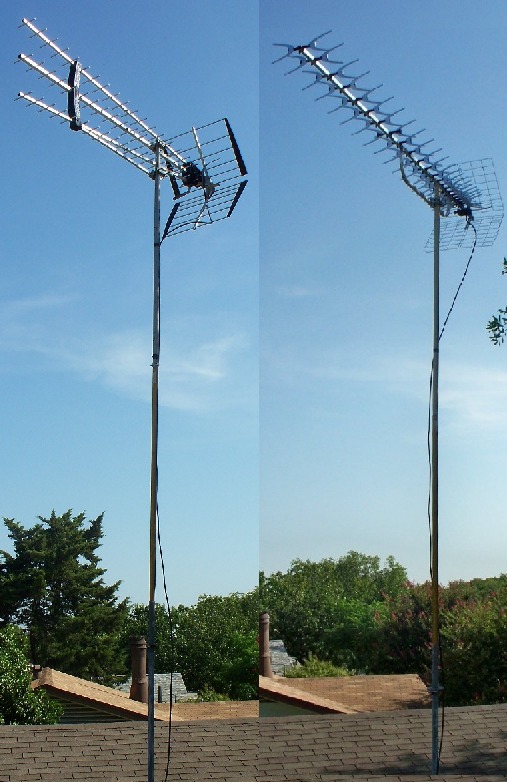A pair of UHF antennas were compared:
Antennas Direct 91XG and Televes DAT-75
Both antennas have built-in baluns.
Equipment used in the tests:
- Push-up sectioned mast with two ~5 ft. extensions
- Fifty feet RG6 quad shield coaxial cable (CATV grade)
- Sencore SLM1456CM (Digital signal level meter)
The Sencore 1456 can scan channels, after each channel is locked-on and signal strength and quality measured, it tunes to the next channel and repeats until all channels have been analyzed. The 1456 saves the results as normal computer files, they can be downloaded for later analysis.
Signal sources: Multiple DTV stations in the Dallas/Fort Worth area. All stations generally located at the same bearing with LOS at ~29 miles.
The center boom of each antenna was raised to a height of 25 feet above ground (AGL).
The following is an image of the antennas in the test positions:

Test Sequence:
The tests were performed in mid-morning during a 2-day period. For each antenna test, the Sencore 1456 was allowed to scan available UHF stations three times. The first day there were 3 scans for each antenna for a total of 6 scans. On the 2nd day, the tests were repeated for 12 more scans.
A recording (run) consists of the SLM1456CM scanning the UHF band and recording the average signal strength (dBmV) for each channel.
Day 1: 3 consecutive runs with 91XG followed by 3 runs of DAT-75
Day 2: 3 consecutive runs with 91XG followed by 3 runs of DAT-75, then 3 consecutive runs with DAT-75 followed by 3 runs of xg-91.
In all, there were 3 sets of 3 scans for each antenna. Each scan took ~2-3 minutes. So the measurements were no more than 2-3 minutes apart
The results were downloaded and graphed in Excel. All 9 runs for each antenna were averaged together to yield a composite, shown here:

Observing that the 91XG provided the overall highest received signal power, the difference was computed and graphed in the image below:

The 91XG had about 1 dB more gain for the mid portion of the UHF band.
The two antennas were nearly equal at the lower channels.
These results can be rationalized as follows:
The DAT-75
- Large reflector & essentially a stacked pair of driven elements provide lower frequency gain.
- The 3-stack spacing becomes wider (in terms of wavelength) at upper frequencies, increasing gain.
The 91XG
- Colinear directors (X directors) and long boom length provide high gain thru the band.
.